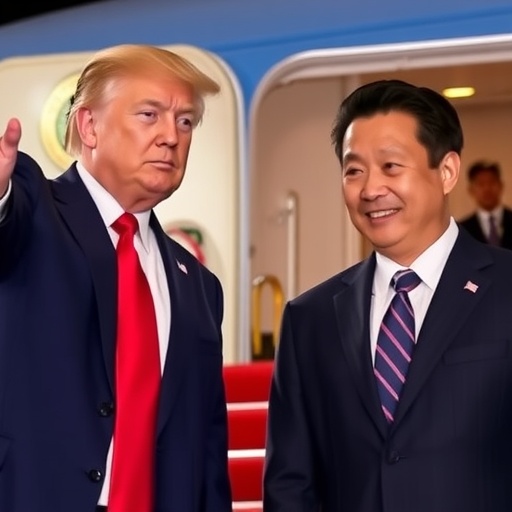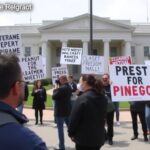President Trump Lands in Japan for Three-Day Summit with PM Takaichi Amid Escalating Security Tensions
In a move that underscores the urgency of trans-Pacific partnerships, U.S. President Donald Trump touched down in Tokyo on Monday, marking his inaugural overseas trip since reclaiming the White House in his second term. The three-day visit, shrouded in heightened security protocols due to mounting regional threats, will center on bolstering the U.S.-Japan alliance with newly appointed Prime Minister Sanae Takaichi. As North Korean missile tests and Chinese naval maneuvers cast long shadows over the Asia-Pacific, this summit arrives at a critical juncture, promising discussions on defense, trade, and shared democratic values.
Trump‘s Arrival Signals Renewed Focus on Indo-Pacific Strategy
Air Force One’s wheels touched down at Haneda Airport under a blanket of crisp autumn skies, greeted by a phalanx of Japanese officials and U.S. Secret Service agents. President Trump, fresh from his January inauguration, wasted no time in emphasizing the visit’s importance. “Japan is a cornerstone of American strength in the region,” Trump declared in a brief statement upon arrival, flanked by Vice President JD Vance and key advisors. This journey, his first official state visit post-reelection, deviates from his first-term playbook, where domestic priorities often overshadowed international travel. Back then, Trump’s 2017-2021 tenure saw just one trip to Japan amid trade spats and pandemic disruptions; now, with a more assertive foreign policy agenda, the itinerary reflects a pivot toward countering authoritarian influences.
The backdrop to this visit is no secret: escalating security concerns have gripped the Indo-Pacific. According to a recent Pentagon report, North Korea conducted over 90 missile launches in 2023 alone, with several overflying Japanese territory. Meanwhile, China’s assertive claims in the South China Sea have prompted Japan to ramp up its defense budget by 26% to ¥7.9 trillion ($56 billion) for fiscal 2024—the highest ever. Trump’s administration has already signaled intentions to deepen military interoperability, building on the Quad alliance (U.S., Japan, Australia, India) that saw joint exercises increase by 40% since 2021.
Security wasn’t just rhetoric; the visit’s logistics reflect the gravity. Tokyo’s streets buzzed with an unprecedented deployment: over 20,000 police officers, drone surveillance, and even U.S. carrier strike groups patrolling nearby waters. “This isn’t just a courtesy call—it’s a statement of resolve,” said Dr. Emily Chen, a senior fellow at the Brookings Institution, in an interview with Reuters. Her words echo the sentiment in Washington, where lawmakers from both parties have urged Trump to reaffirm Article 5 commitments under the U.S.-Japan Security Treaty, which obligates mutual defense.
Takaichi’s Leadership Ushers in Era of Assertive Diplomacy
Prime Minister Sanae Takaichi, who ascended to the premiership in September after a surprise Liberal Democratic Party shift, represents a bold new chapter for Japan. A staunch conservative with roots in former Prime Minister Shinzo Abe’s inner circle, Takaichi has prioritized national security from day one. Her appointment came amid domestic turmoil, including a slush fund scandal that toppled her predecessor, but her hawkish stance on defense has won plaudits from allies. “Strengthening the U.S.-Japan alliance is not optional—it’s essential for our survival,” Takaichi stated in her inaugural address, vowing to revise Japan’s pacifist constitution to allow for more proactive military roles.
The Trump-Takaichi meeting, scheduled for Tuesday at the Imperial Palace, will delve into these synergies. Sources close to the Japanese Foreign Ministry indicate agenda items include expanding joint missile defense systems, with Japan eyeing U.S. Tomahawk deployments on its Izumo-class carriers. Takaichi, often dubbed “Abe’s protégé,” shares Trump’s transactional worldview, having previously advocated for fairer burden-sharing in alliance costs. During Trump’s first term, Japan agreed to host more U.S. Marines and increase host-nation support payments to $2 billion annually—a figure Takaichi aims to leverage for technology transfers in hypersonic weapons.
Personal chemistry could prove pivotal. Trump, known for his affinity for strongman diplomacy, has praised Takaichi’s “toughness” in past social media posts. Their discussions may also touch on human rights, with Takaichi pushing for coordinated responses to China’s Uyghur crackdowns and Hong Kong erosions. As one Japanese diplomat quipped anonymously to The Asahi Shimbun, “This duo could be the spark Japan needs to step out of its shell.” Historical context bolsters this optimism: the U.S.-Japan alliance, forged in the 1951 treaty and tested during the Cold War, has evolved into a bulwark against proliferation, with shared intelligence thwarting at least three North Korean cyber incursions last year alone.
Navigating Security Flashpoints: From Pyongyang to Beijing
At the heart of the summit lies the specter of regional instability. Security concerns dominate the docket, with Trump and Takaichi expected to unveil a joint statement on deterring aggression. North Korea’s Kim Jong Un has accelerated its nuclear program, amassing an estimated 50 warheads by U.S. intelligence assessments. Just last week, a Hwasong-18 ICBM test splashed down perilously close to Japan’s exclusive economic zone, prompting Tokyo to scramble F-15 jets for the 15th time this year.
China looms larger still. Beijing’s military budget, surpassing $230 billion in 2023, dwarfs Japan’s, fueling tensions over the Senkaku Islands (known as Diaoyu in China). Trump, who branded China an “existential threat” during his campaign, is likely to press for Japan’s participation in the U.S.-led AUKUS pact, potentially sharing nuclear submarine tech. “We can’t afford complacency,” warned Admiral Samuel Paparo, head of U.S. Indo-Pacific Command, in congressional testimony. Statistics paint a stark picture: Chinese warplane incursions into Taiwan’s air defense zone hit 1,700 last year, with Japanese airspace violations up 50%.
To address these, the leaders may announce enhanced exercises like Keen Sword, the biennial drill involving 57,000 troops, now incorporating AI-driven simulations for cyber warfare. Japan, under Takaichi, has committed to acquiring 400 Tomahawk missiles, a $2.3 billion deal that ties directly into U.S. supply chains. Quotes from the ground level humanize the stakes: in Okinawa, where 70% of U.S. bases in Japan are located, residents like fisherman Hiroshi Tanaka express mixed feelings. “We want peace, but Trump’s visit reminds us we’re on the front lines,” Tanaka told CNN.
Beyond bilateral ties, the summit eyes multilateralism. Trump has hinted at revitalizing the Trans-Pacific Partnership (TPP), from which he withdrew in 2017, to counter China’s Belt and Road Initiative. Takaichi, a free-trade advocate, could bridge this gap, especially as Japan’s GDP growth hit 1.9% in Q3 2024, buoyed by exports to the U.S.
Economic Pillars Underpinning the U.S.-Japan Alliance
While security headlines the agenda, economic interdependence forms the alliance’s bedrock. The U.S. and Japan, the world’s largest and third-largest economies, exchanged $218 billion in goods last year, with automobiles and semiconductors leading the charge. Trump’s visit revives memories of his 2019 Osaka G20 spat, where he accused Japan of currency manipulation—a charge Tokyo refuted. Now, with inflation cooling, talks may focus on supply chain resilience, particularly rare earth minerals dominated by China.
Takaichi’s government has poured ¥10 trillion into semiconductor fabs, partnering with U.S. firms like Intel and TSMC. “This alliance isn’t just about guns—it’s about innovation,” Trump tweeted en route, highlighting a potential $50 billion joint fund for AI and quantum computing. Trade experts predict outcomes like eased tariffs on U.S. beef and soybeans, which could boost American farmers by 15%, per USDA estimates.
Challenges persist: Japan’s aging population and yen weakness (at 150 to the dollar) strain fiscal balances. Yet, optimism prevails. The U.S.-Japan Digital Trade Agreement, signed in 2019, has digitized 80% of bilateral transactions, reducing costs by $1.2 billion annually. As economist Dr. Kenji Sato of Tokyo University notes, “Trump’s deal-making style complements Takaichi’s pragmatism, potentially unlocking a new golden era.”
Charting the Path Forward: Lasting Impacts of the Tokyo Summit
As the three-day visit unfolds—with a state dinner Wednesday and a news conference Thursday—eyes worldwide turn to potential breakthroughs. Beyond immediate pacts, the summit could reshape global dynamics. A fortified U.S.-Japan alliance might embolden Taiwan, deter Russian overtures to Pyongyang, and pressure multilateral forums like the UN Security Council, where Japan seeks a permanent seat.
Looking ahead, Trump’s team eyes follow-on visits to South Korea and the Philippines, weaving a “latticework of alliances,” as Secretary of State Mike Pompeo described in a recent op-ed. For Japan, success here validates Takaichi’s mandate, possibly stabilizing her coalition ahead of 2025 elections. Risks remain: domestic protests in Okinawa over base expansions could sour optics, and any Trumpian tariff threats might derail economic goodwill.
Ultimately, this visit reaffirms a partnership forged in fire—from Pearl Harbor to Hiroshima—and tempered by shared prosperity. As Trump departs Friday, the echoes of strengthened resolve may ripple across the Pacific, offering a beacon amid turbulent seas. Analysts forecast that, if realized, these commitments could deter aggression for a decade, saving trillions in potential conflict costs. In Takaichi’s words, shared during a pre-visit briefing: “Together, we stand unbreakable.”








